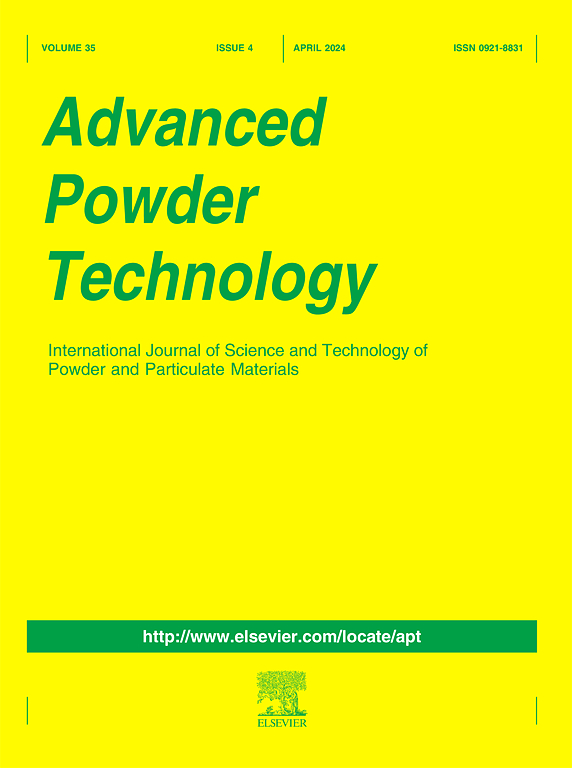Sustainable application of coal fly ash: Alumina recovery from coal fly ash by low-temperature roasting with potassium persulfate
IF 4.2
2区 工程技术
Q2 ENGINEERING, CHEMICAL
引用次数: 0
Abstract
This study introduces a novel process for recovering Al2O3 from coal fly ash (CFA), utilizing potassium persulfate (K2S2O8) as an activator, and explores the decomposition behavior of both crystalline and amorphous alumina phases within CFA. The experiment involved mixing K2S2O8 with CFA in K2S2O8/Al2O3 molar ratios ranging from 0.5:1 to 4:1, followed by calcination at varying temperatures and durations to optimize alumina extraction. The results indicated that the alumina extraction efficiency of 91 % was achieved with a molar ratio of 3:1 (K2S2O8/Al2O3), calcination temperature of 405 °C, and reaction time of 2 h. X-ray photoelectron spectroscopy, scanning electron microscopy, and reaction kinetics were employed to analyze the reaction mechanism. The findings revealed that K2S2O8 preferentially reacted with the amorphous alumina phase, leading to the breakage of Al–O–Si bonds. The release of SO2 and O2 during the reaction further facilitated the breakdown of the crystalline phase by disrupting aluminum–oxygen tetrahedra. Simultaneously, the silicon-oxygen tetrahedra decomposes and forms SiO2 gel layer, wrapping the remaining aluminum oxygen octahedron, thus preventing further alumina extraction. This study contributes to a deeper understanding of the decomposition behavior of crystalline and amorphous alumina phases in CFA during sulfate roasting. The findings provide a theoretical foundation for refining alumina recovery processes and offer significant improvements to existing sulfate roasting methods.

粉煤灰的可持续利用:过硫酸钾低温焙烧法回收粉煤灰中的氧化铝
本研究介绍了一种利用过硫酸钾(K2S2O8)作为活化剂从粉煤灰(CFA)中回收Al2O3的新工艺,并探讨了CFA中结晶和非晶氧化铝相的分解行为。在K2S2O8与Al2O3的摩尔比为0.5:1 ~ 4:1的条件下,将K2S2O8与CFA混合,然后在不同的温度和时间下进行煅烧,以优化氧化铝的提取。结果表明,在K2S2O8/Al2O3摩尔比为3:1、煅烧温度为405℃、反应时间为2 h的条件下,氧化铝提取率可达91%。利用x射线光电子能谱、扫描电镜和反应动力学对反应机理进行了分析。结果表明,K2S2O8优先与非晶氧化铝相反应,导致Al-O-Si键断裂。反应过程中SO2和O2的释放通过破坏铝氧四面体进一步促进了晶相的分解。同时,硅氧四面体分解形成SiO2凝胶层,包裹剩余的铝氧八面体,从而阻止了氧化铝的进一步提取。本研究有助于更深入地了解硫酸盐焙烧过程中CFA中结晶和非晶态氧化铝相的分解行为。研究结果为精炼氧化铝回收工艺提供了理论基础,并对现有硫酸盐焙烧方法进行了重大改进。
本文章由计算机程序翻译,如有差异,请以英文原文为准。
求助全文
约1分钟内获得全文
求助全文
来源期刊

Advanced Powder Technology
工程技术-工程:化工
CiteScore
9.50
自引率
7.70%
发文量
424
审稿时长
55 days
期刊介绍:
The aim of Advanced Powder Technology is to meet the demand for an international journal that integrates all aspects of science and technology research on powder and particulate materials. The journal fulfills this purpose by publishing original research papers, rapid communications, reviews, and translated articles by prominent researchers worldwide.
The editorial work of Advanced Powder Technology, which was founded as the International Journal of the Society of Powder Technology, Japan, is now shared by distinguished board members, who operate in a unique framework designed to respond to the increasing global demand for articles on not only powder and particles, but also on various materials produced from them.
Advanced Powder Technology covers various areas, but a discussion of powder and particles is required in articles. Topics include: Production of powder and particulate materials in gases and liquids(nanoparticles, fine ceramics, pharmaceuticals, novel functional materials, etc.); Aerosol and colloidal processing; Powder and particle characterization; Dynamics and phenomena; Calculation and simulation (CFD, DEM, Monte Carlo method, population balance, etc.); Measurement and control of powder processes; Particle modification; Comminution; Powder handling and operations (storage, transport, granulation, separation, fluidization, etc.)
 求助内容:
求助内容: 应助结果提醒方式:
应助结果提醒方式:


